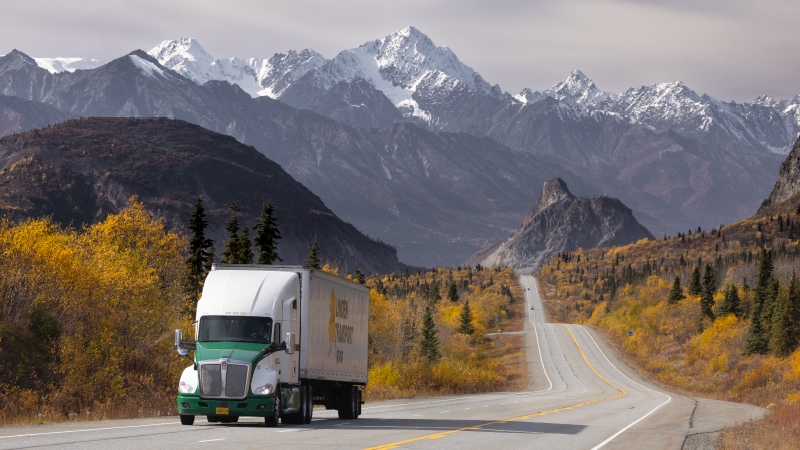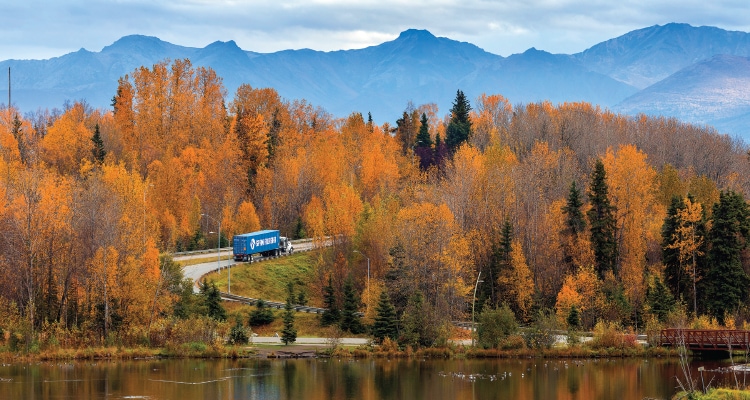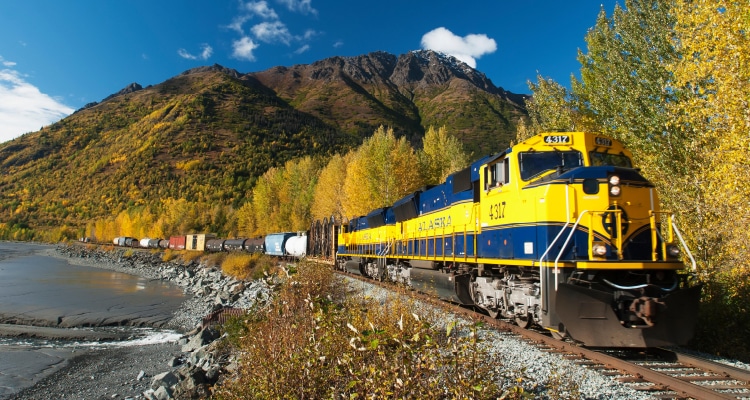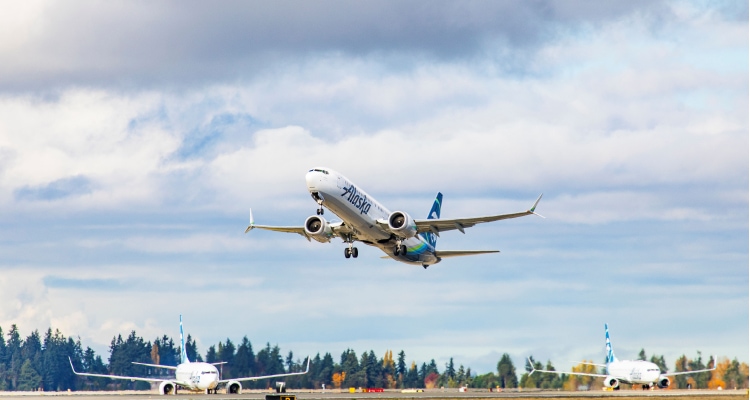Alaska: Terrain for the Tenacious

The logistics challenges of Alaska are met—and overcome—by enterprising and innovative logistics professionals who make it their mission to serve the people of the Frontier State.
Alaska is the most expansive and challenging logistics laboratory in the United States. Though a perplexing number of people believe otherwise, it is not an island. It has a land connection to Canada in addition to its commercial and social connections with the United States and the rest of the world. The vast expanse of Alaska became the 49th U.S. state on January 3, 1959, when President Dwight D. Eisenhower signed the declaration admitting Alaska to the union.
One thing stayed the same: Alaska remains a broad region presenting an array of unique logistics challenges. “I like to say that if you can manage logistics to, from, and within Alaska, you can manage logistics anywhere in the world,” says Dr. Darren Prokop, professor emeritus of logistics in the College of Business and Public Policy at the University of Alaska Anchorage.
Resourceful and resilient logistics professionals are meeting Alaska’s challenges, handling logistics over the roughest terrain, and the state is significantly better for it. “Alaska’s socio-economic fabric is highly dependent on logistics,” Prokop says. “The largest state in the United States (more than double the size of Texas) is separated from the rest of civilization and surrounded by the vast Pacific and Arctic oceans and the Yukon wilderness.”
While it is one of the country’s least populous states, Alaska’s population is widely dispersed across an environment subject to earthquakes, tsunamis, volcano eruptions, blizzards, and floods. “On top of all that, Alaska’s transportation infrastructure is concentrated in the center of the state between Anchorage and Fairbanks,” says Prokop. Given the population concentration, the Port of Alaska has become the principal gateway for large-volume freight deliveries to those cities.
Alaska’s distinctive configuration means logistics professionals must know their way around and through the state’s demanding land and water obstacle course. “You can’t fake logistics,” Prokop says. “Either the shipment is on time, or it isn’t. This is especially crucial for Alaska.”
About 90% of Alaska’s inbound freight arrives by water. The Port of Alaska’s share of this serves about 85% of all Alaskans. “Importantly,” Prokop says, “of the amount that arrives in Anchorage, only half is for local residents.”
Navigated by specialists experienced in the logistics challenges of Alaska, freight makes its way to the state’s bustling cities as well as remote villages and towns. (The state’s name is derived from the Aleut word “Alyeska,” literally meaning “the object towards which the action of the sea is directed.”)
Feeding the Flow
The state’s own abundant natural resources are shipped throughout the world. For example, Alaska’s fisheries—the source of such delicacies as halibut and king crab—are in the world’s most treacherous waters.
Additionally, “Alaska’s oil helps power the nation and is transported from one end of the state to the other by the 800-mile engineering marvel known as the Trans-Alaska Pipeline System (TAPS),” notes Prokop.
The state’s impressive logistics infrastructure includes highly valuable assets such as Ted Stevens Anchorage International Airport, one of the top air cargo facilities in the world. The airport’s geographic advantage is that it is within 9.5 hours flying time to 90% of the industrialized world. Being at the center of the great circle route between U.S. and Asia markets, it is not surprising most cargo planes stop in Anchorage to refuel.
“Apart from this geographic advantage is the airport’s operational advantage,” Prokop adds. “Its special air cargo transfer rights are unique to the airport and these allow foreign planes to transfer their cargo between them. It is a variation of a form of trade liberalization known as cabotage and it makes a rare example of unilateral trade liberalization by the United States for the benefit of Asia-Pacific trade flows.”
Meeting All Tests

Span Alaska moves more than 400 million pounds of freight annually throughout Alaska, offering chill/freeze services for perishables, food and beverage, and medical/pharmaceutical shipments.
The transportation and logistics infrastructure of Alaska has been tested over time and terrain, and through all types of severe weather, yet it remains resilient and able to serve all Alaskans, no matter how central or remote they are.
“The transportation infrastructure is one of the most resilient—and geographically dispersed—in the country,” says Michael Johnson, president of Span Alaska, which connects Alaska to the rest of the United States, and the world, with a weather-tested transportation network over land, sea, and air.
“Due to Alaska’s size, its weather, and lack of road infrastructure, delivering products can be complicated and challenging,” says Johnson.
But as the state’s largest freight forwarding company transporting freight and shipments to, from, and around Alaska, Span Alaska meets the challenges and ships more than 400 million pounds of freight annually throughout the state. The company utilizes ocean container service, barges, and trucks ranging from semi-trailers to step vans, flatbeds, and air and rail service to deliver to its customers.
Span Alaska, launched in 1978, opened the largest DC and service center of its kind in the state in Anchorage in 2019. The facility has 88 dock doors, a lay-down area for breakbulk cargo, and an in-house maintenance shop.
Expanding Services
In 2023, the company opened a new and expanded service center in Fairbanks, Alaska’s second-largest city. Span Alaska has additional service centers in Wasilla, Juneau, Soldotna/Kenai (in the Kenai Peninsula Borough), and Kodiak.
Span Alaska direct loads containers to service centers from its consolidation center in Auburn, Washington, near the Port of Tacoma. “That means customers’ shipments are loaded into shipping containers destined directly for one of the six service centers or the Anchorage air cargo facility,” Johnson explains. “This eliminates rehandling and costly delays. The shipments are not rehandled or devanned and reloaded along the way.”
Span Alaska offers expanded chill/freeze services for perishables, food and beverage, and medical/pharmaceutical shipments.
The company offers Keep From Freezing (KFF) options, usually from late September to April, for products that would be compromised or damaged if they freeze in transit.
Johnson is enthusiastic about Alaska and Span Alaska’s place in it. “Alaskans live here because they love the natural beauty, the wilderness steps from their door, access to fishing, hunting, and hiking, and the pristine environment,” he says. “Whether they are in metro cities or a remote bush village, they need reliable availability of food, clothing, and everything else for everyday life. Because of the commitment and service of Span Alaska and other logistics providers, Alaskans can enjoy the same access to goods and services that those in the Lower 48 have.”
Span Alaska continues to invest in technology and provides instant tracking and delivery confirmations. “Shipment visibility is vital for customers, especially as their products can be shipped via several modes—ocean, road, rail, and air,” he adds. Span Alaska offers delivery throughout Alaska, from metro Anchorage to the North Slope to remote villages in the bush.
Customized solutions are available for the commercial and industrial sectors, including oil and gas, construction, food and beverage, and retail/tourism.
Making Tracks

Alaska Railroad provides critical freight service, bringing freight from the lower 48 states through its gateway of Seattle, Washington, and into the port of Whittier, Alaska.
Contributing mightily to the transportation and logistic solutions of Alaska is the Alaska Railroad, which provides passenger service to most of the population with routes traveling some 500 miles between Seward, Anchorage, and Fairbanks.
The railroad also provides critical freight service, bringing freight from the lower 48 states through its gateway of Seattle, Washington, and into the port of Whittier, Alaska.
“We operate two distinctive services to meet the needs of the people and business in Alaska—rail freight and passenger service,” explains Dale Wade, the railroad’s vice president, marketing and customer services. While best known for its passenger service, Alaska Railroad freight is the larger of the railroad’s two business segments.
“The Alaska Rail Marine Barge, operated under a long-term contract to the Alaska Railroad, connects the lower 48 states to Alaska via a port operation just a stone’s throw from downtown Seattle on Harbor Island,” Wade says. “There, rail carloads that originated deep in Texas and Mexico move seamlessly without transloading onto a rail barge for the seven-day trip to Whittier, a few miles from Anchorage. This is the most cost-effective way to move container and full railcars to and from Alaska.”
Maintaining a Critical Energy Link
The railroad is mindful of its responsibility to the critical chain of the energy and mining industries as well as to consumers in the expansive commerce center of Alaska, says Wade.
While the challenges presented by the state’s terrain are numerous—including extreme cold, flooding, rockslides, and avalanches—Wade says there are no obstacles the railroad cannot overcome.
“Because we are remote, we don’t rely on third-party services that are available to railroads in the lower 48 states,” he explains. “If it happens, we handle it. This requires us to be prepared, well-planned, and extremely resourceful.”
A common misconception is that the Alaska Railroad is connected to the lower 48 states via a railroad in Canada. “While there have been several big resource projects that have looked at building a connection between the Alaska Railroad and the Canadian National Railway, none has taken the process beyond the planning phase,” he says. “The barge connection between Harbor Island, Washington, and Whittier, Alaska, continues to be the only method to get railcars to south central Alaska from the lower 48.”
Unless delayed by weather or other circumstances, the barge sails weekly on Wednesday and arrives in Whitter one week later. Each barge can carry 40-50 railcars.
Due to current demand, the Alaska Railroad has contracted an extra sailing every Friday in addition to the weekly scheduled sailings.
The future of the Alaska Railroad promises to be as rewarding as its past. “We just completed our centennial year in 2023,” Wade says. “The first 100 years were both challenging and exciting. The next 100 years will bring so many more opportunities for us. Alaska is rich in culture and resources but has limited infrastructure. No doubt our next chapter will be about expanding the system in a responsible and sustainable way to meet market demands as they arise.”
Flying High

Alaska Air Cargo serves 20 communities across Alaska and is set to launch a dedicated freighter service between Anchorage and Los Angeles, through Seattle, in spring 2024.
Alaska’s air carrier infrastructure is vital so that both passengers and essential cargo can be transported into remote communities. Playing a crucial role in transporting people, products, and supplies to and from Alaska is Alaska Airlines, the fifth-largest airline in North America when measured by scheduled passengers carried. Through its airline partners and the oneworld global alliance, Alaska Airlines passengers can travel to more than 1,000 destinations on more than 20 airlines.
Headquartered in SeaTac, Washington, just outside Seattle, Alaska Airlines is now the only passenger airline in the United States with dedicated cargo planes, and it connects with large international and integrated carriers to carry ecommerce goods and other critical supplies into and around Alaska. Alaska Air Cargo is the largest scheduled cargo carrier in the Frontier State.
Alaska Air Cargo’s growing freighter fleet will expand its reach to Los Angeles (LAX) in spring 2024—the first time its dedicated freighters, which serve 20 communities across the state of Alaska, will connect to cities beyond Seattle (SEA) in the lower 48.
The two newest 737-800BCF freighters can carry 10,000 more pounds than the airlines’ three 737-700 freighters. Many of the groceries, household goods, and essential medicine shipping into the state of Alaska come from Southern California, and this new freighter route will streamline that supply chain, says Adam Drouhard, managing director for Alaska Air Cargo.
The bigger freighters will also be in full service in time for the height of the salmon fishing season, allowing fresh sustainable sockeye from Bristol Bay and other fisheries to reach markets across the lower 48 more quickly. “We are excited to build on our long history serving the state of Alaska and forge new connections between communities there and cities across the United States,” Drouhard says.
More freighters in the schedule serving the state of Alaska will also improve the reliability of that service. “Our markets in the state will get more dedicated service that’s not shared,” Drouhard says. “We’ll be able to spread that schedule across more aircraft.”
Bethel (BET), Juneau (JNU), and Sitka (SIT) will be among the first communities to benefit from the bigger freighters and more frequent service. The aircraft’s expanded range also will allow the cargo team to explore other new routes, such as a possible nonstop from King Salmon (AKN) to Seattle.
Prospects for continued growth are excellent, especially against the backdrop of the state’s overall logistics strengths. For example, Alaska Air Cargo’s services are facilitated by Ted Stevens Anchorage International Airport, which has long played an integral role in the growth of Anchorage and the state.
The airport’s geographic location provides unlimited potential for moving goods, services, and infrastructure to be used in the global marketplace. For Alaska Airlines, that means easier connections from rural Alaska to global markets, which is particularly important for the efficient and fast export of wild Alaskan seafood. There is potential for ecommerce and other goods coming into the state to be transported around Alaska more quickly as well, which is very good news for communities that are not on the road system, allowing faster delivery of goods around the state.
Seeing Possibilities for Innovation
Where others may see only roadblocks, the logistics specialists at Lynden—a family of companies providing transportation and logistics solutions in Alaska, as well as Canada, the Pacific Northwest, Hawaii, and around the world—see opportunities to create innovative solutions.
“Alaska logistics are different, but not insurmountable,” says Alex McKallor, Lynden’s executive vice president and COO.
Offsetting the state’s logistics challenges is its strategic location, offering literal and figurative “top-of-the-world” access to Asian, European, and North American markets.
“The strategic location of Alaska is very advantageous,” McKallor says, emphasizing both its air cargo assets and its “incredible” coastline.
“Alaska has over 6,000 miles of coastline, and if you count the islands, almost 50,000 miles of actual coastline,” he notes. Some 2,670 named islands help contribute to Alaska’s rank as the state with the largest land mass in the United States.
“Alaska’s coastline’s proximity to its natural resources is a tremendous advantage,” McKallor says. “Our business model is built around filling the gaps in infrastructure, which reaches only a small fraction of the vast area of Alaska.
“We build our business strategy around filling those gaps in the best way possible. Where you don’t see a road, you see a marine, air, or another solution. We use interesting things like PistenBully snowcats (used in heavy snow and ice), hovercrafts, and Hercules aircraft to access areas unreachable by other methods.”
Lynden’s experience in Alaska is applicable in other hard-to-navigate places too. “Some of these issues are not necessarily unique to Alaska,” McKallor says. “What makes us especially effective is that as an asset-operating transportation company we know the pitfalls and risks of proposed logistical plans. What may be theoretically possible may not be practically possible and have a high risk of failure. If a certain part of the plan for a logistics project doesn’t pan out it could have catastrophic effects on the success of the project.”
In those instances, Lynden has the practical knowledge and ability to turn to alternative methods. “That’s where we add a lot of value when it comes to advice and helping customers,” he says.
Looming energy and mining projects bode well for Alaska’s continued strategic importance throughout the world. “We’re bullish on Alaska,” he says. “Alaska is very well positioned to be a critical natural resource supplier, especially with the focus on trying to develop secure supply chains for strategic minerals.”
He refers to the current era as “the century of the Pacific,” and he believes the next five years will see greater investment in the energy and mining sectors. “Our focus is to support these projects wherever we can.”
“Large projects with large swings in volume can be disruptive to existing supply chains,” McKallor says. “The most important thing to Lynden is to make sure we can continue to serve our existing customers with reliable service.”
Fortifying the Future
Alaska’s presence as an American state gives the country an enhanced definition. “Alaska makes the United States an Arctic nation,” notes Prokop. “As such, it is on the frontier of the wealth of resources that are being discovered in the Arctic Ocean. In the decades ahead, Alaska will also play a major role in opening the Arctic to transportation via the Northwest Passage and the Northern Sea Route.”
He is proud the University of Alaska Anchorage contributes to the state’s assets through its logistics and supply chain management programs.
“We teach students how to plan well and use their imagination,” he says. “It took a lot of imagination and daring to build Alaska into the logistics powerhouse it is today.”
Alaska on Top of the World?
Myths about Alaska are as vast and meandering as the area itself. Much of the confusion arises from the state’s appearance on a typical map of the world, says Dr. Darren Prokop, professor emeritus of logistics in the College of Business and Public Policy at the University of Alaska Anchorage.
Where is Alaska? Most people would likely answer the question after conjuring up a map in their heads, Prokop says. They might say: “Alaska is at the top of the world.”
Well, everyone does say that, even many who regularly write about the state. Not so?
“Well, they would be right—but only to the extent that a flat earth wall map is an accurate depiction of a round, three-dimensional earth,” Prokop says. “With apologies to the Flat Earth Society, such maps are not accurate. There is no ‘top’ of the world. In fact, Alaska is equidistant between the major population centers of Far East Asia and the Lower 48 if one travels the shortest distance between them. But one could never tell that by looking at a wall map.”
In this case, the reality is better than the myth.
“The consequence of these ‘great circle routes’—the shortest distance between two points on a sphere—is that all airplanes using them would fly over Alaska,” Prokop says. “Also, ocean vessels traveling from Asian ports to those along the U.S. West Coast use shipping lanes that follow great circle routes which are not too far off Alaska’s shores.”
So, perhaps surprising to those who are not logisticians, a more accurate answer to the question is: “Alaska is at the center of world trade.”
Alaska RFP/RFI
"*" indicates required fields
